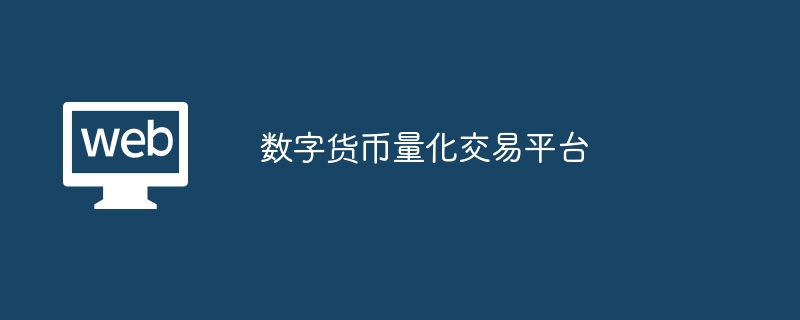The digital currency quantitative trading platform is a platform that specifically provides quantitative trading services for digital currency investors and traders. As an important part of the digital currency market, the digital currency quantitative trading platform provides efficient and flexible trading services for professional traders. With the continuous advancement of technology and the increasing maturity of the market, these platforms are expected to achieve more prosperous and sustainable development in the future. Facing challenges such as technical thresholds, data security, and regulatory risks, platforms need to continuously innovate and improve to respond to market changes and user needs.

1. Overview
The digital currency quantitative trading platform is specifically designed to provide quantitative trading for digital currency investors and traders. A platform for trading services. Quantitative trading, that is, quantitative investment strategies, mainly relies on complex mathematical models and algorithms to predict market trends and automatically execute trading strategies through in-depth analysis of historical data. These platforms not only provide traditional trading functions, but also integrate advanced quantitative analysis tools and algorithmic trading systems to meet the high requirements of professional traders for strategic flexibility and trading efficiency.
2. Functional features
Quantitative strategy development: The platform provides a complete set of quantitative strategy development tools. Allows users to write and execute trading algorithms based on their own trading strategies. These tools typically include strategy editors, strategy backtesting systems, and strategy execution engines.
Algorithmic Trading: By integrating advanced algorithmic trading systems, the platform can implement multiple trading strategies such as high-frequency trading, stop-loss and take-profit, which greatly improves the flexibility of trading. and efficiency.
Data analysis and mining: The platform provides a wealth of data analysis and mining tools to help users extract valuable information from massive market data to inform strategies Formulate and provide data support.
Risk Control: The platform has a complete risk control system, including fund management, position control, stop loss and stop profit and other risk control methods to ensure user funds safety.
API interface and automated trading: The platform provides an API interface, allowing users to access the platform programmatically to achieve automated trading and strategy deployment.
Transaction Monitoring and Reporting: The platform provides real-time transaction monitoring and reporting functions to help users understand the transaction situation in real time and adjust trading strategies in a timely manner.
3. Technical Architecture
The technical architecture of a digital currency quantitative trading platform usually includes the following parts:
User interface layer: Responsible for processing user requests, displaying the trading interface, strategy editor and data analysis tools, etc.
Business logic layer: Implement transaction business logic, including order processing, fund management, risk control, etc.
Algorithmic trading layer: Responsible for executing quantitative trading strategies, including the implementation of algorithmic trading systems and strategy execution engines.
Data layer: Store and manage market data, user data, transaction data, etc.
Security layer: Ensure the security and stability of the platform, including network security, data security and system security.
4. Advantages and Challenges
Advantages:
Flexibility: The quantitative trading platform allows users to write and execute trading algorithms according to their own trading strategies, with Extremely high flexibility.
Efficiency: The algorithmic trading system can implement a variety of trading strategies such as high-frequency trading, which greatly improves trading efficiency.
Risk Control: The platform has a complete risk control system that can effectively reduce transaction risks.
Challenge:
High technical threshold: Quantitative trading requires a deep foundation in mathematics and programming, technology The threshold is higher.
Data security: The platform needs to handle a large amount of sensitive data, and how to ensure data security is an important challenge.
Regulatory Risk: As the digital currency market continues to develop, regulatory policies may also change, bringing uncertainty to platform operations.
5. Future Development Trend
Technological Upgrading and Innovation: With artificial intelligence and big data With the continuous development of other technologies, quantitative trading platforms will continue to improve their technical strength and launch more intelligent and efficient trading tools and strategies.
Compliance and Supervision: As the digital currency market continues to mature, regulatory policies will also gradually improve. Quantitative trading platforms need to pay close attention to regulatory developments to ensure business compliance operations.
Globalization layout: As the globalization trend of the digital currency market becomes increasingly obvious, quantitative trading platforms need to actively expand overseas markets and provide high-quality transactions for global users. Serve.
Ecological Co-construction: The quantitative trading platform can cooperate with other financial institutions, technology providers, etc. to jointly build a digital currency quantitative trading ecosystem and promote the healthy development of the entire industry.
User experience optimization: The platform will continue to optimize the user experience, provide simpler, more intuitive and personalized interfaces and functions, and reduce users’ learning and usage costs.
6. Conclusion
As an important part of the digital currency market, the digital currency quantitative trading platform provides professional traders with efficient and flexible transaction services. With the continuous advancement of technology and the increasing maturity of the market, these platforms are expected to achieve more prosperous and sustainable development in the future. However, in the face of challenges such as technical thresholds, data security, and regulatory risks, the platform needs to continue to innovate and improve to respond to market changes and user needs.
The above is the detailed content of Digital currency quantitative trading platform. For more information, please follow other related articles on the PHP Chinese website!